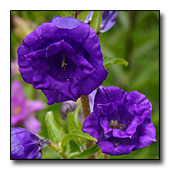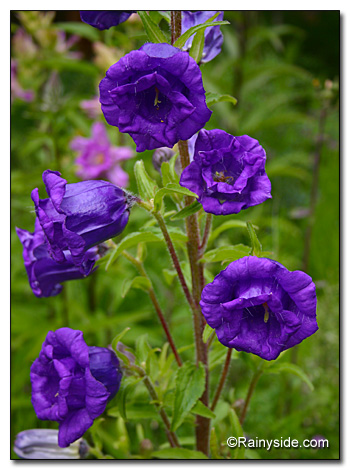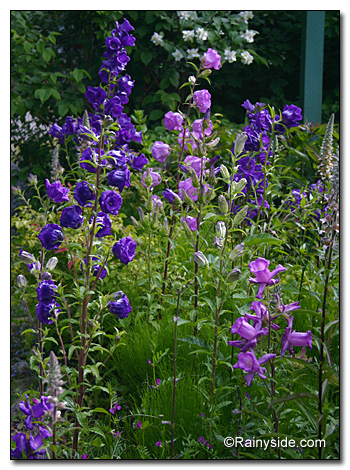Campanula medium 'Calycanthema'
CUP AND SAUCERS, CANTERBURY BELLS
Family: Campanulaceae
Pronounced: kam-PAN-yew-lah

Quick Jumps
Growing Guide
Rainy Side Notes
GROWING GUIDE

Origin:
Southern France.
Plant Group:
Annual or biennial.
Hardiness:
Sunset zones: 1-9, 14-24.
USDA zones: 5-8.
Mature size:
Height: 30 inches (75 cm).
Width: 12 inches (30 cm).
Flowering period:
Summer.
Flowering attributes:
Single or double, pink, rose, lavender, white, or blue flowers on loose racemes. Each flower is surrounded by a calyx of the same color as the petals giving it a cup and saucer look.
Leaf attributes:
Lance-shaped, green basal leaves.
Light:
Full sun to partial shade. Full sun is best in our maritime climate.
Soil:
Moist, well-drained fertile soil.
Feeding:
Add complete organic fertilizer when planting and again the following spring.
Propagation Methods:
Surface sow seed and keep moist at 68°F (20°C), germinates (60% germination rate) in less than two weeks. Start indoors in February for flowering the same year or start in summer for flowers the following year.
Pests and Diseases:
Slugs can be a problem when the plants are young. Grow healthy plants to reduce problems with spider mites and aphids.
Rainy Side Notes


This classic biennial is excellent as a cut flower and a must for the cottage garden. Canterbury bells thrive in our cool maritime climate of the Pacific Northwest and can be treated as an annual if started indoors in February. It will bloom six months after seeds are sown. C. medium 'Calycanthema' is used in flowerbeds, borders, cut flowers and massed plantings. Keep the spent flowers deadheaded to prolong the bloom time. Stake plants before the flowers open to keep racemes upright, unless of course you like the look of flopping flowers.
It is said that the common name Canterbury bells was given to the plant during the 12th century. The flowers resembled the bells worn by the horses that carried people to the shrine of Thomas A Becket, Archbishop of Canterbury, at Canturbury Cathedral.
For cut flowers, pick after one or two flowers are open. The flowers will last in vase up to 8 days; more when floral preservatives are added to the vase water.
Debbie Teashon
Photographed in author's garden.
A Pacific Northwest Plant of the Week (2012)

Gardening for the Homebrewer: Grow and Process Plants for Making Beer, Wine, Gruit, Cider, Perry, and More
By co-authors Debbie Teashon (Rainy Side Gardeners) and Wendy Tweton
Copyright Notice | Home | Search | Annuals

